This post may contain affiliate links, which means I'll earn a small commission if you purchase something through these links. You won't pay any extra; instead, you'll be helping Aloha With Love to thrive. Thank you! Learn more.
--
Once the plumbing was all set up and working, it was time to fill up my grow beds with media. There are all kinds of options when you go down the rabbit hole of YouTube aquaponics. There’s the well-known clay pebbles (Hydroton), as well as cheaper options such as river rock, expanded shale, or gravel. Each comes with their own set of pros and cons, so do your research and find out what’s going to work best for you and your system.
About lava rock as a media
Since we’re in Hawaii, a popular media choice is lava rock. It’s cheap, there’s plenty of it available, it won’t affect the pH, and it’s very porous, which increases the living area for the good bacteria that will convert the fish ammonia to NO2 and eventually NO3 (non-toxic to fish).
I decided to go with lava rock (aka cinder). There are two types of lava rock here: red cinder and black cinder.
Red cinder is larger and typically measures 2 – 3 inches long. Most of the photos in this blog post are of red cinder because initially I was scared that the smaller black cinder would clog my pipes and filter. Unfortunately, red cinder is just too big to use by itself. It leaves too much space between rocks so the plants can’t grow a strong root foundation and they would topple over constantly.
I recommend going with the black cinder, which measures about 1/4 to 1/2 inch. If you choose to fill up your grow beds completely with black cinder, be sure to make a really great media guard to prevent the black cinder from escaping your grow bed. Or, you can do what I did: fill the bottom of the grow bed with the larger red cinder and fill in the remaining area with black cinder.
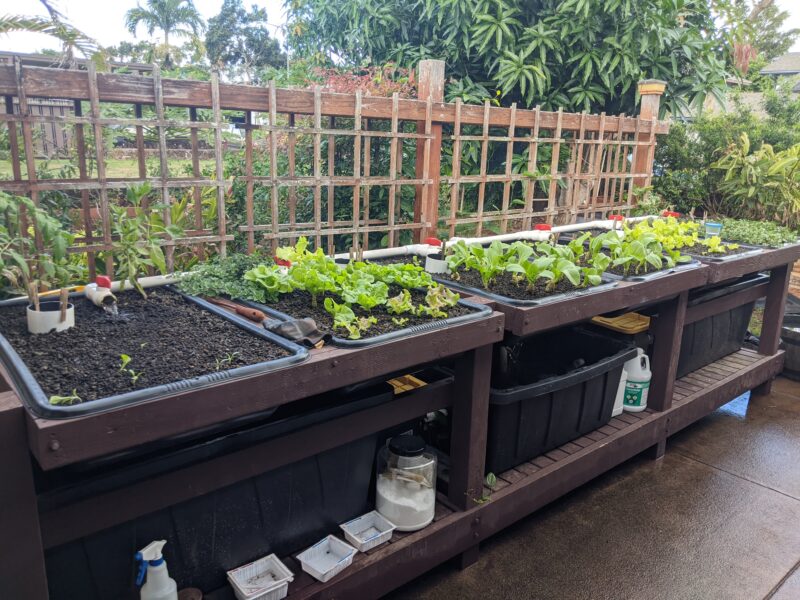
Lava rock has several pros that I mentioned earlier. It’s cheap and affordable here in Hawaii, won’t change your pH, and is very porous. After working with it for a few months now, I only have 3 cons about it:
- It’s rough on the hands/gloves. This isn’t such a big problem right now because I’m not moving the rocks around on a daily basis. But moving them from the truck to the grow bed (and moving them out when I realized that the red cinder was too big) shredded my gloves and nails.
- Cleaning lava rocks are a huge hassle. They are very dusty and dirty and cleaning this one truckload took me a whole day. I basically kept the hose running 8 hours straight. When I was done, I was left with a large mound of crunchy dirt that filled up an entire wheel barrow. I couldn’t dump this debris in my yard and it was heavy sediment that I had a difficult time shooting into the gutter.
- Black cinder in particular is light and fragile. I’m not sure what’s going to happen when a hurricane hits us because I’m pretty sure a lot of the light lava rock will fly out and make a crunchy mess out of our yard. The lava rocks are also crushable. Again, it’s not such a problem right now because I don’t touch them much anymore, but I can step on them and they’ll break.
But overall, I really like working with black cinder as a media. It does what I need it to do, it has the great advantage of more room to house good bacteria, and most importantly it’s cheap.
I purchased my red and black cinder from Kiso Store in Waipahu, which I highly recommend you visit if you’re looking for bulk cinder, gravel, sand, pavers, brick, and other landscaping supplies. In total I spent a little over $100 on the media for this aquaponic system. $80 for one full scoop (about half a truck load) and 6 bags of black cinder from Walmart.
Local Tip: At the time of writing this post, I checked the prices for bags of cinder at both Walmart and City Mill. City Mill was priced a little higher at $6+, so I went with Walmart since I was furloughed at the time due to the pandemic.
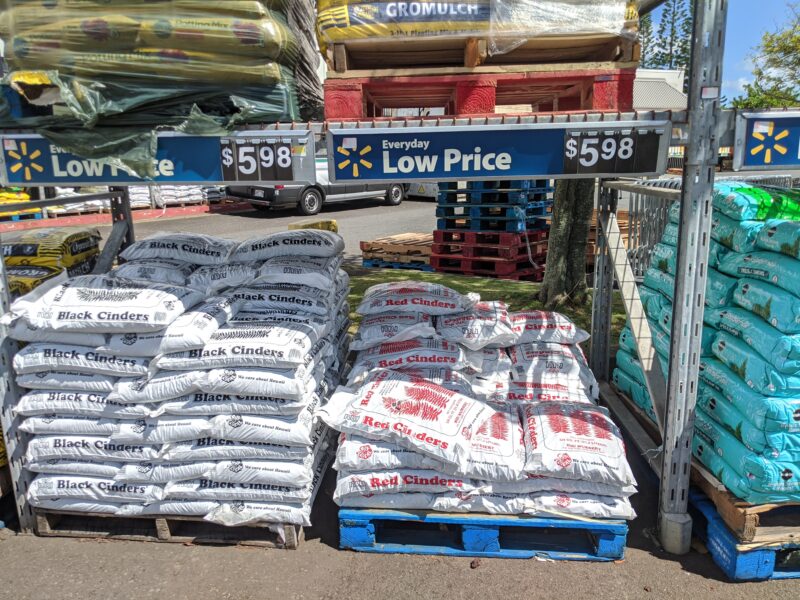
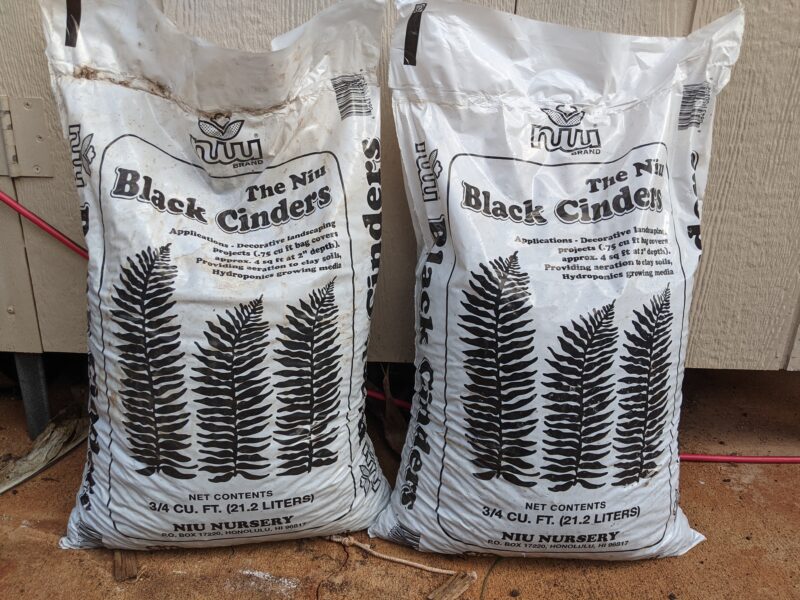
Cleaning and rinsing the lava rock
One of the biggest cons of using lava rock as your media is that you have to rinse off a lot of dirt and powdery grit off of them before you place them in your grow beds. It doesn’t matter if it’s red or black cinder.
Because they’re so porous, they create a lot of dirt as they rub against each other. Dad and I spent a whole day rinsing and shoveling these rocks from the truck to the grow beds. Even after a good rinse, there was still a lot of residual dirt that collected at the bottom of my fish tanks and filter buckets.
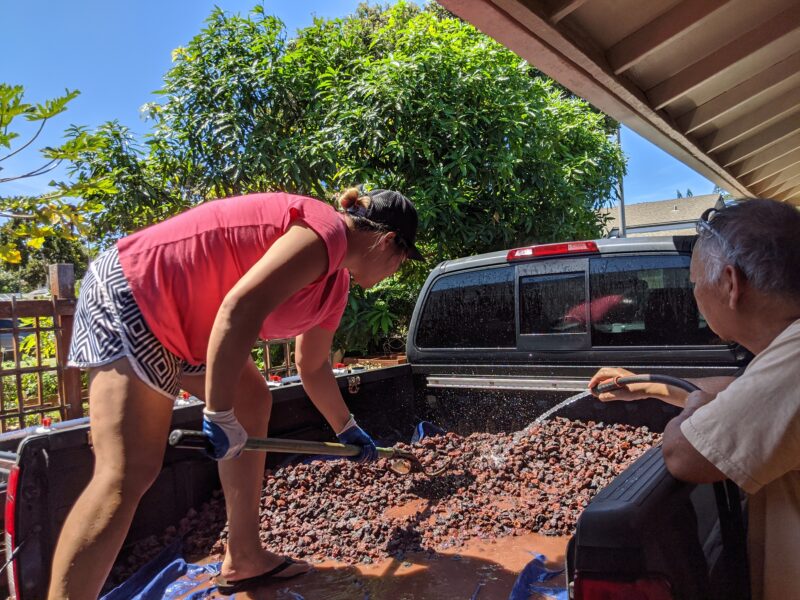

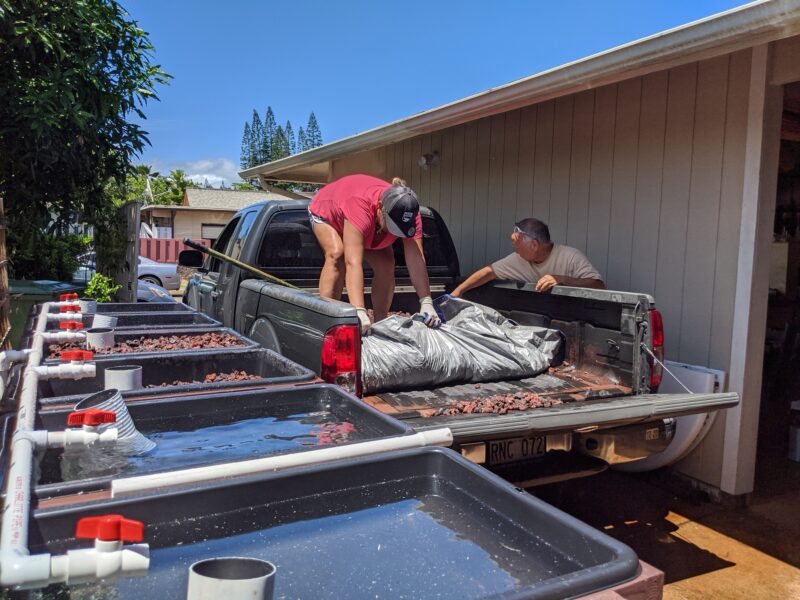
What worked for us was working in sections and using gravity to our advantage. Dad started by spraying the top of the mound with water and I would use the shovel to turn the rocks so that he could rinse the underside off. I took the clean rocks and placed them in the grow beds, but as you can tell from the pictures, there was enough residual dirt to discolor the water.
Local Tip: We’re lucky because we could back up the truck right next to the system. However, if you don’t have the space to do this, you’ll have to use a wheelbarrow, which can be extremely tiring and time-consuming because you’re adding another step to the process.
To protect my hands, I wore new gardening gloves that were coated with a thick rubber in the front. By the end of the day, they had holes near the fingertips so definitely invest in some good gardening gloves if you plan to do this.

Also, once everything is cleaned, you’ll end up with a heavy and solid mass of dirt (more like heavy sediment). It was especially hard to clean this up because I couldn’t really throw it in the yard or in the rubbish can. What I ended up doing was shooting it down the driveway and into the gutter near my house. So consider how you’ll do your cleanup – it took me over an hour to spray it off into the gutter because the spray from the hose wasn’t quite strong enough to move the sediment.
Finishing up
At the end of the day, my grow beds were filled up and I had sprayed the remaining sediment off the driveway and into the gutter 1 house down. I had run the pump and siphons several times (with the drain pipes turned out into the yard) until the water ran clear.
My yard was a tiny bit flooded and I did feel like I wasted water, but it was worth it because now I only have to top it off about once a week. So am I saving water in the long run? Yes, definitely. The sun doesn’t hit the water in the fish tanks or sump tank directly so very little water is lost through evaporation.
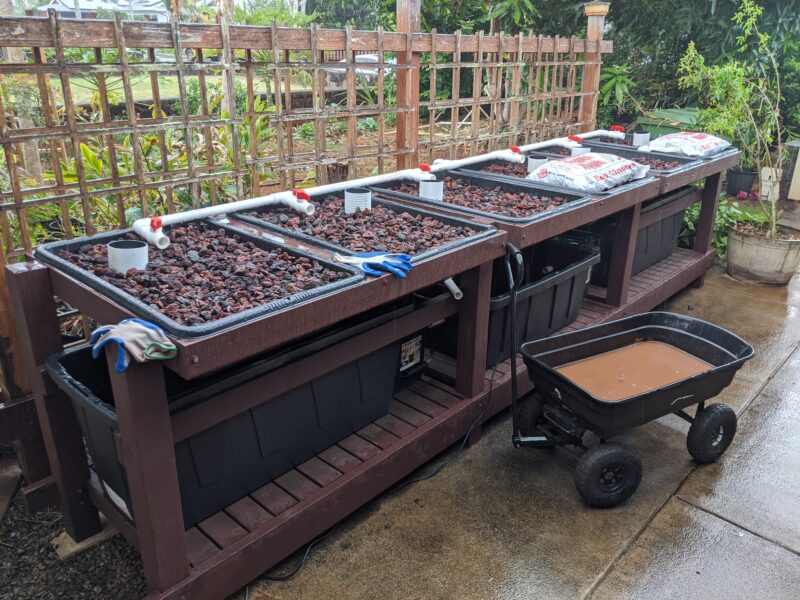
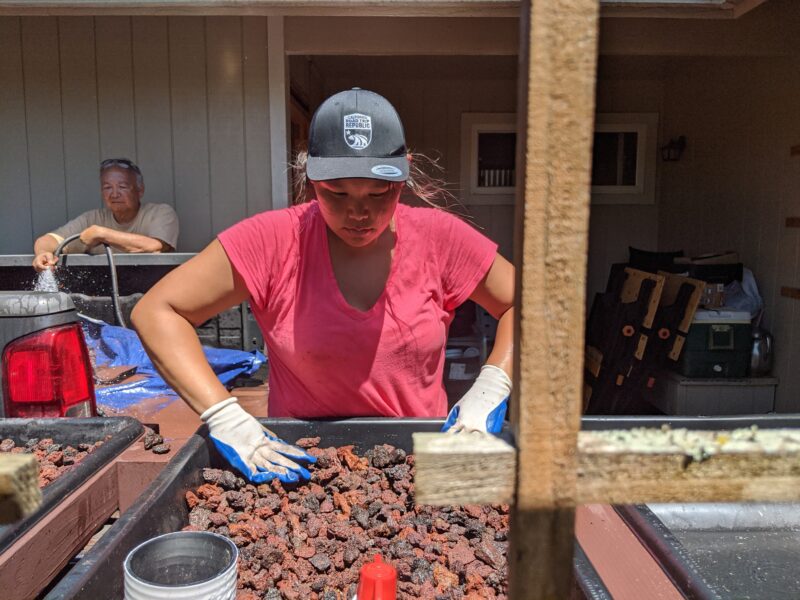
I did end up buying a few bags of cinder from my local Walmart to raise the rock level about an inch or so for all the grow beds. I also adjusted my standpipe during this time and pushed most of them down by an inch. For most of them I could see the water rising so by raising the rock level and lowering the standpipe, I got a good proportion.
A few notes about black cinder
I eventually figured out that red cinder is just too big to do a good job as media for aquaponics. Black cinder is a much better option that I highly recommend you consider. Working with black cinder is very similar to red cinder. You’ll still have to clean it and you’ll need more of it because of it’s smaller size. If anything, it is even more dusty/dirty than red cinder so be prepared for extra rinsing.

The really great thing about black cinder is that you can germinate seeds right in your system. There’s no need to germinate seeds in the dirt, indoors, or someplace else and than transfer it into your aquaponics system. So far, I’ve successfully germinated a variety of lettuce, tomatoes, peppers, squash, bok choy, kale, and more.
As the plants sprout and grow, they’re very stable in the black cinder and don’t topple over (like they did when I had only red cinder). The roots can push and dig through the black lava rock very easily because they are so lightweight.
Overall, lava rock is a great option for an aquaponics media that I can recommend. There are a lot of important advantages and the only major con is that the cleaning and rinsing takes so much time and manpower. But it’s just a one time thing and once the job is done you have a really nice setup that works well for the fish, bacteria, and plants.
Have you tried lava rock as a media or are you considering it? Let me know your questions or experiences in the comments!
Aloha with love,
Amy

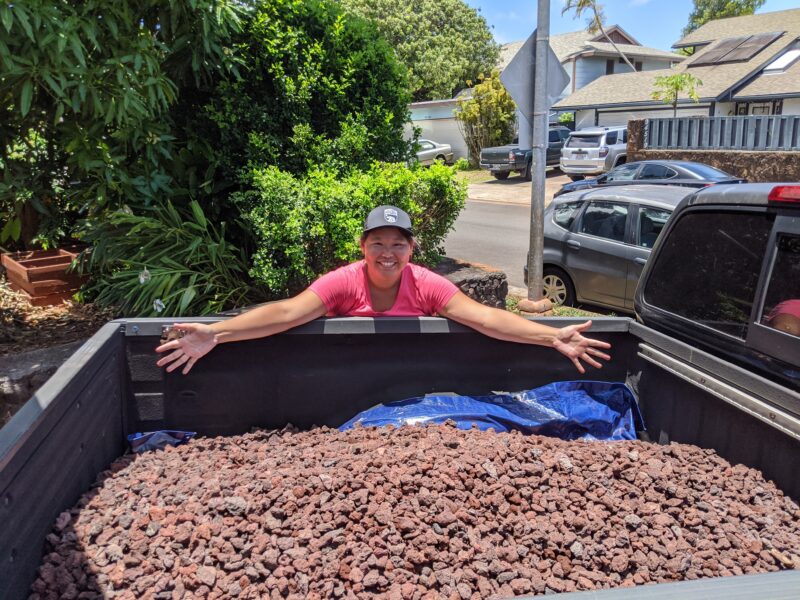
I’m very much impressed with the effort you put into cleaning all that cinder getting the ebb and flow system going. Looks like it’s gong to be a very productive aquaponics operation. I use black cinder in Dutch buckets watered from my 1000 gallon aquaponics. It works great! Aloha from Puna. Marcos
Aloha Marcos! So far it’s been very productive! We’re getting a lot of leafy greens and the yields have been great. Wow – 1000 gallons! I have 2 IBC chop and flips set up in the backyard (I’ll do another post on them soon) and have been thinking about doing a dutch bucket setup there since we have some extra space. Thanks for reading! Aloha with love, Amy.
hi
i would like to thank you for your effort you put in order to teach others. in my culture this act is religion act.
thank you again
hashem